Experimental Investigation of Compressive Concrete with Different Immersion Times and Its Stochastic Damage Model
Abstract
:1. Introduction
2. Experimental Procedure
2.1. Raw Materials
2.2. Specimen Preparation
2.3. Experimental Setup
- (1)
- At the beginning of the test, the specimen was placed between the loading panels of the test machine with talcum powder for reducing friction, and the loading control system was used to control the loading actuator and increase the load to the presetting load value (i.e., 0.5 kN for this test) with a constant loading rate, to ensure that the surfaces of the specimen were flat and the loading actuator was aligned during the test.
- (2)
- Subsequently, three preloads were carried out (the load was set as 30% of the estimated bearing capacity of the specimen).
- (3)
- Finally, the test was conducted in the load-controlled loading mode and displacement-controlled loading mode during different stages; in detail, the load-controlled loading mode was adopted before the specimen reached the peak-bearing capacity, and the displacement-controlled loading mode was adopted after the peak-bearing capacity.
3. Experimental Results and Analysis
3.1. Strength Deterioration of Wet Concrete
3.2. Stress–Strain Curves of the Wet Concrete under Compression
3.3. Saturation Effects on the Mechanical Properties of Wet Concrete
4. Stochastic Damage Model of Wet Concrete under Compression
4.1. Damage Model of Wet Concrete in the Sense of the Mean Value
4.2. Stochastic Damage Model of Wet Concrete
4.3. Model Verification
5. Discussion
5.1. Transition from the Microscale to the Macroscale
5.2. Comparison of the Mean Stress–Strain Curves of Concrete with Different Immersion Times
5.3. Characteristics and Limitations of the Stochastic Damage Model
6. Conclusions
- (1)
- The degradation evolution of mechanical property for concrete with different immersion times under uniaxial compression was obtained, and the shape of the stress–strain curves of the wet concrete was similar to that in the literature.
- (2)
- The proposed stochastic damage model was able to consider both effects of the saturation and the damage behavior of wet concrete under compression. It was verified by comparing with the experimental results in this paper and the classical experimental results from the literature.
- (3)
- The model was capable of evaluating the mean and standard deviation of the stress–strain curve. The proposed model was validated by comparing the predicted and experimental results. The results show a good agreement between the predicted and experimental results. In addition, the predicted results based on the average stress–strain curves were compared with the experimental results.
- (4)
- A further exploration of the behaviors of wet concrete was obtained by examining the media process in terms of transition from the microscale (microstructure) to the macroscale (macroresponse). It was found that the lognormal distribution density function can represent well the damage probability density for wet concrete under compression when compared to the Weibull and Gauss distribution density functions.
Author Contributions
Funding
Institutional Review Board Statement
Informed Consent Statement
Data Availability Statement
Conflicts of Interest
References
- Ma, B.; Chu, Y.; Huang, X.; Yang, B. Influence Mechanism of the Interfacial Water Content on Adhesive Behavior in Calcium Silicate Hydrate−Silicon Dioxide Systems: Molecular Dynamics Simulations. Appl. Sci. 2023, 13, 7930. [Google Scholar] [CrossRef]
- Beskopylny, A.N.; Stel’makh, S.A.; Shcherban’, E.M.; Mailyan, L.R.; Meskhi, B.; Chernil’nik, A.; El’shaeva, D.; Pogrebnyak, A. Influence of Variotropy on the Change in Concrete Strength under the Impact of Wet–Dry Cycles. Appl. Sci. 2023, 13, 1745. [Google Scholar] [CrossRef]
- An, M.; Liu, Y.; Zhang, G.; Wang, Y. Properties of Cement-Based Materials with Low Water—Binder Ratios and Evaluation Mechanism under Further Hydration Effect. Appl. Sci. 2023, 13, 9946. [Google Scholar] [CrossRef]
- Yang, G.; Lv, C. Experimental Study on Influence of Water Content on Compressive Strength of Concrete. J. Jiangsu Vocat. Coll. Constr. Technol. 2012, 12, 13–15. (In Chinese) [Google Scholar]
- Zhang, W.Y.; Chen, Y.J. Effect of different soaking times on the strength of concrete foundation pile core samples. Mod. Prop. (Up. J.) 2012, 11, 84–86. (In Chinese) [Google Scholar]
- Sathiparan, N.; Rumeshkumar, U. Effect of moisture condition on mechanical behavior of low strength brick masonry. J. Build. Eng. 2018, 17, 23–31. [Google Scholar] [CrossRef]
- Wang, W.; Lu, C.F.; Yuan, G.L.; Zhang, Y.L. Effects of pore water saturation on the mechanical properties of fly ash concrete. Constr. Build. Mater. 2017, 130, 54–63. [Google Scholar] [CrossRef]
- Liu, J.; Du, X.L.; Ma, G.W. Macroscopic effective moduli and tensile strength of saturated concrete. Cem. Concr. Res. 2012, 42, 1590–1600. [Google Scholar]
- Kaji, T.; Fujiyama, C. Mechanical Properties of Saturated Concrete Depending on the Strain Rate. Procedia Eng. 2014, 95, 442–453. [Google Scholar] [CrossRef]
- Shen, J.; Xu, Q. Effect of moisture content and porosity on compressive strength of concrete during drying at 105 °C. Constr. Build. Mater. 2019, 195, 19–27. [Google Scholar] [CrossRef]
- Zhang, Y.L.; Zhu, D.Y.; Yao, H.Y.; Li, Y.C.; Gao, G.F.; Ying, G.Z. Study on dynamic and static compression performance of concrete for dry and saturated state and its constitutive relationship. Build. Struct. 2015, 45, 23–27. (In Chinese) [Google Scholar]
- Bai, W.F.; Chen, J.Y.; Fan, S.L. The Statistical Dynamic Damage Constitutive Model of Saturated Concrete under Uniaxial Tension. J. Disaster Prev. Mitig. Eng. 2009, 29, 16–21. (In Chinese) [Google Scholar]
- Chen, Y.L.; Shao, W.; Zhou, Y.C. Ontogenetic model of uniaxial compression elastic-plastic damage in water-saturated concrete. Eng. Mech. 2011, 28, 59–63+88. (In Chinese) [Google Scholar]
- GB 175-2007; Common Portland Cement. Standard Press of China: Beijing, China, 2007.
- GB/T 50081-2019; Standard for Test Methods of Concrete Physical and Mechanical Properties. China Architecture & Building Press: Beijing, China, 2019. (In Chinese)
- Yaman, I.O.; Hearn, N.; Aktan, H.M. Active and non-active porosity in concrete Part I: Experimental evidence. Mater. Struct. 2002, 3, 102–109. [Google Scholar] [CrossRef]
- Lemaitre, J. Evaluation of Dissipation and Damage in Metals Submitted to Dynamic Loading; US Department of Commerce: Washingtone, DC, USA, 1971; pp. 16–19. [Google Scholar]
- Shan, Z. Stochastic Damage Model of Concrete and Its Application. Ph.D. Thesis, Central South University, Changsha, China, 2017. (In Chinese). [Google Scholar]
- GB50010-2020; Code for Design of Concrete Structures. China Architecture & Building Press: Beijing, China, 2020. (In Chinese)
- Gao, J. Study on Stochastic Damage Constitutional Relationship of Self-Compacting Concrete. Ph.D. Thesis, Central South University, Changsha, China, 2016. (In Chinese). [Google Scholar]
- Shao, W. Nonlinear Mechanical Analysis of Fatigue Damage of Concrete and Rock after the Effect of Changing Temperature and Soaking Water. Master’s Thesis, Shanghai University of Technology, Shanghai, China, 2010. (In Chinese). [Google Scholar]
- Shan, Z.; Zhiwu, Y. A fiber bundle-plastic chain model for quasi-brittle materials under uniaxial loading. J. Stat. Mech. Theory Exp. 2015, 11, P11010. [Google Scholar] [CrossRef]

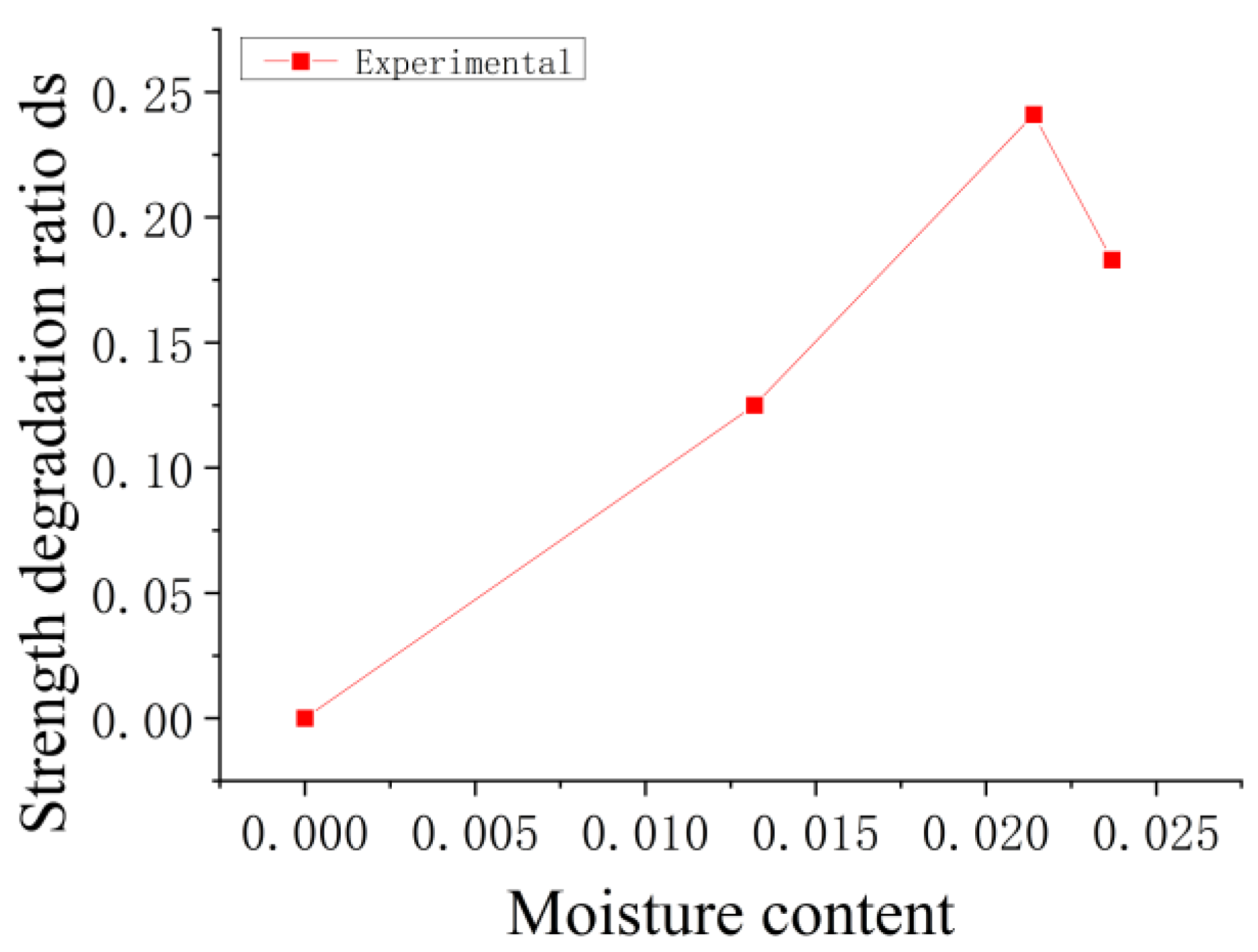

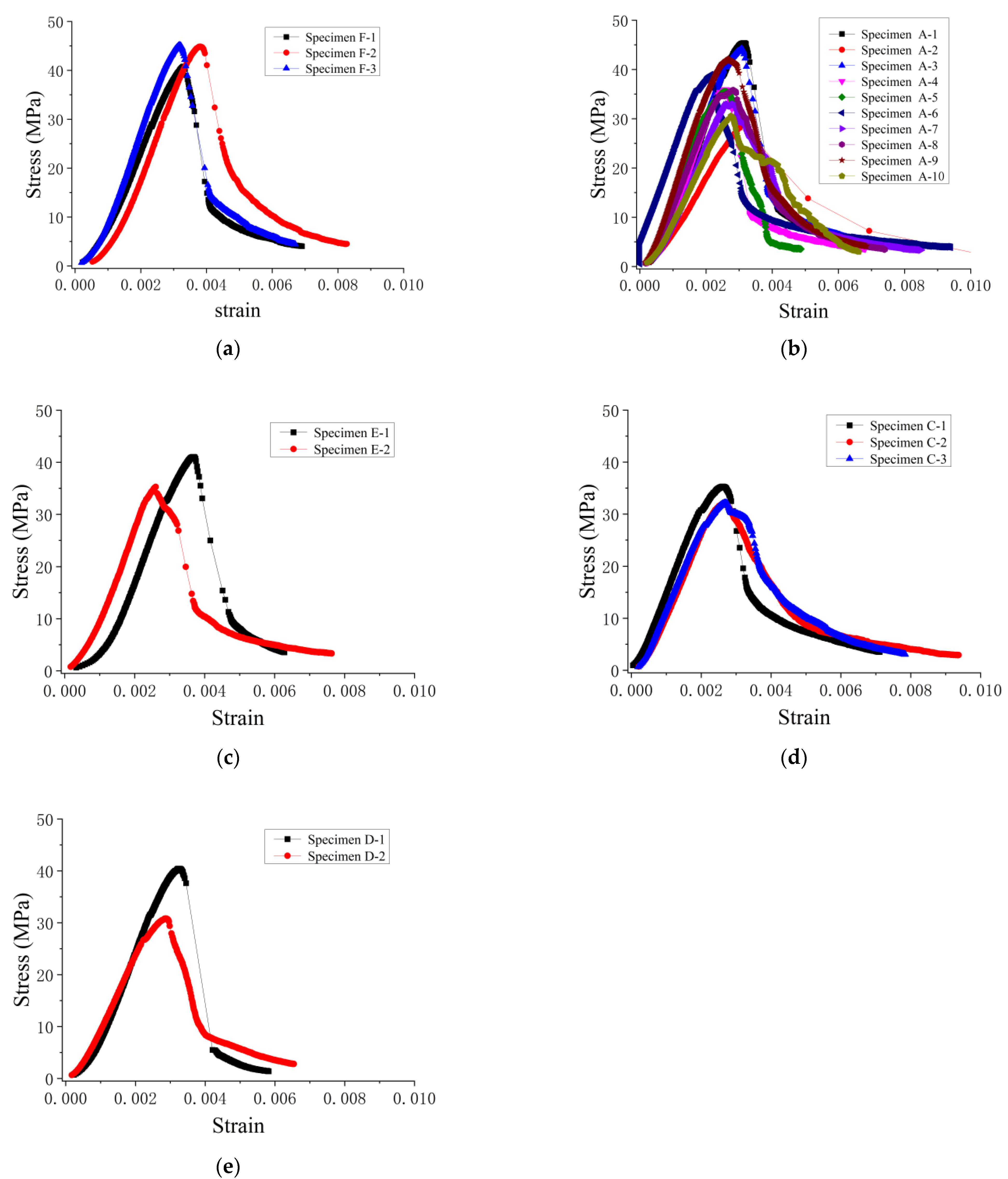

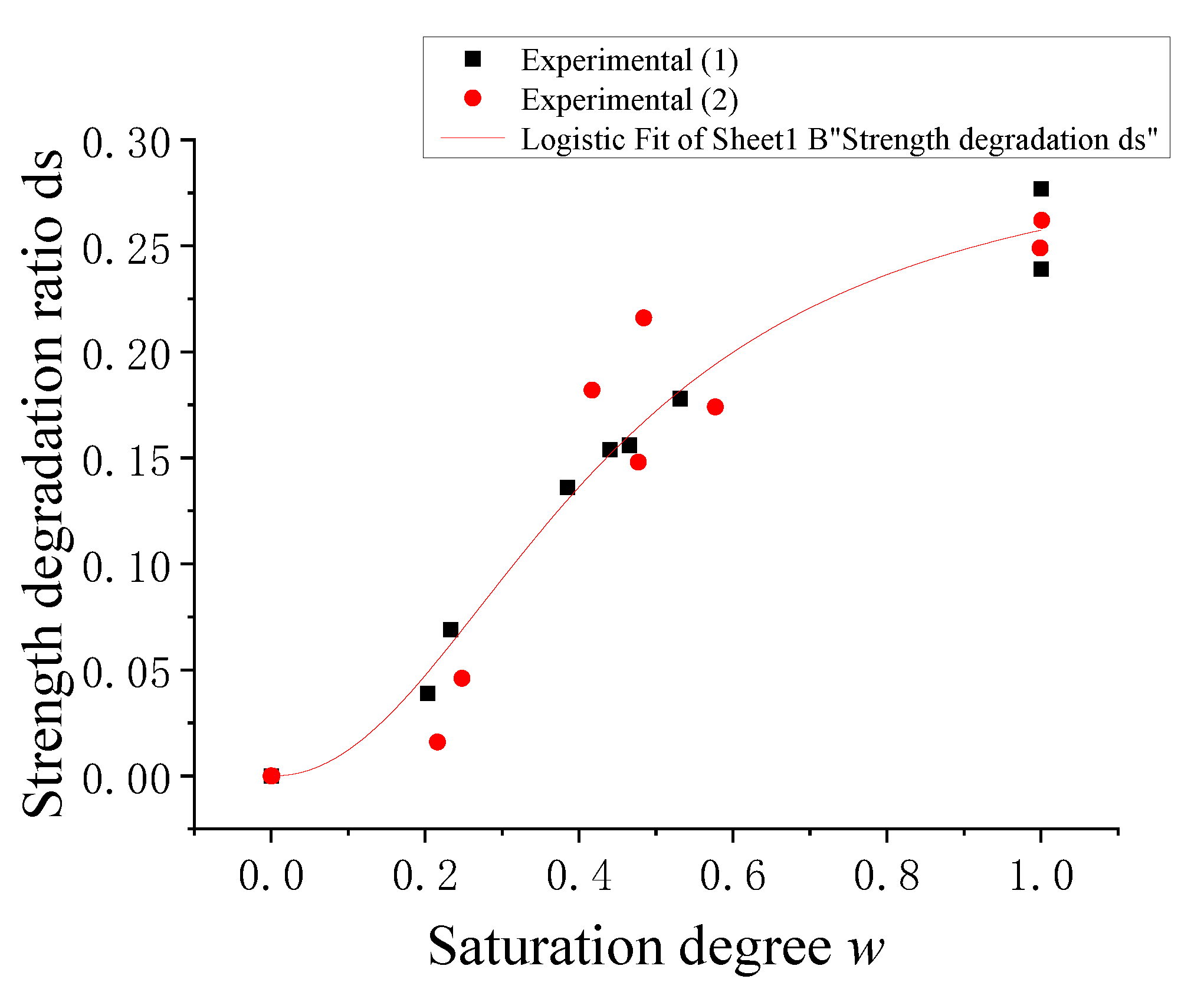
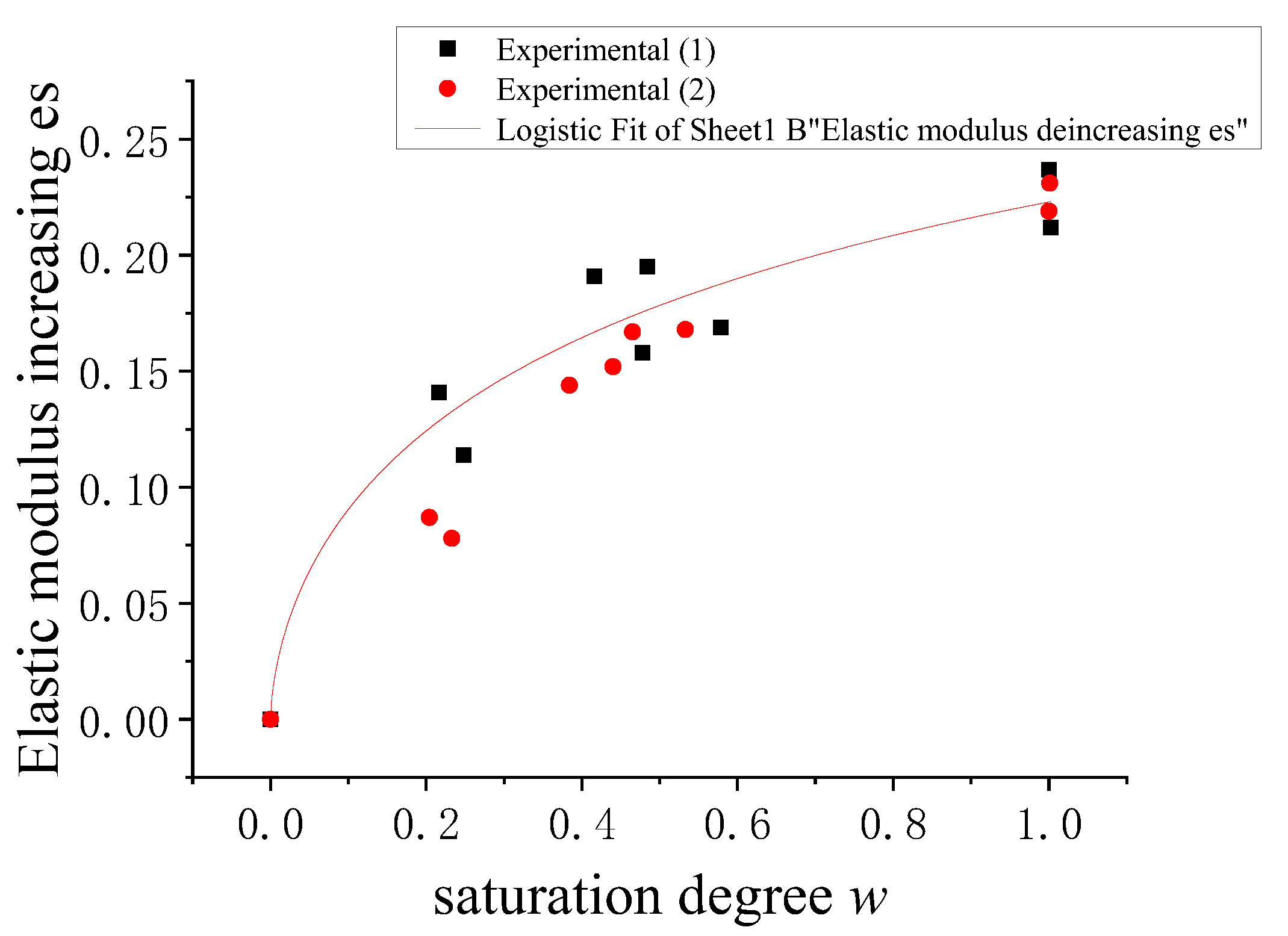

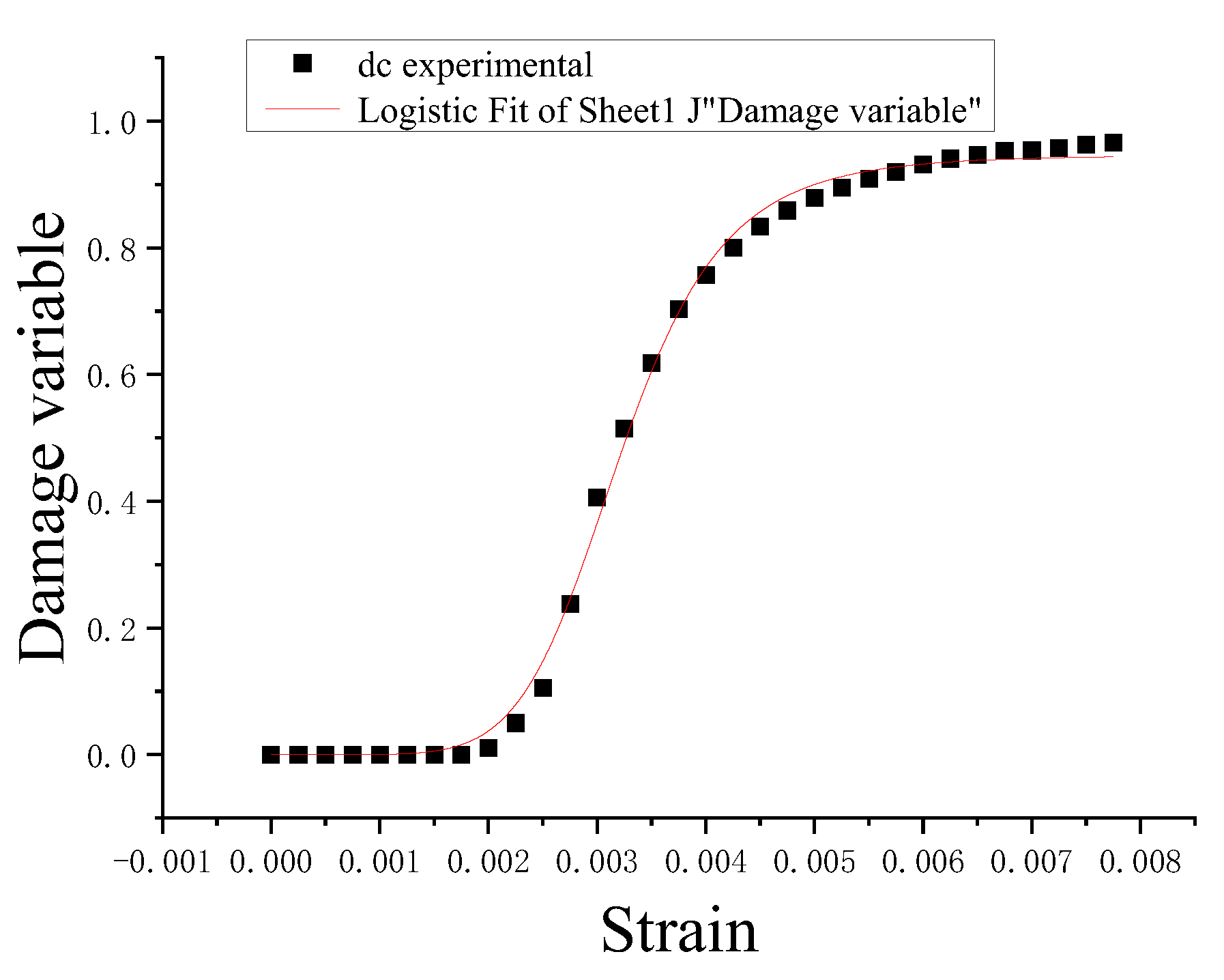



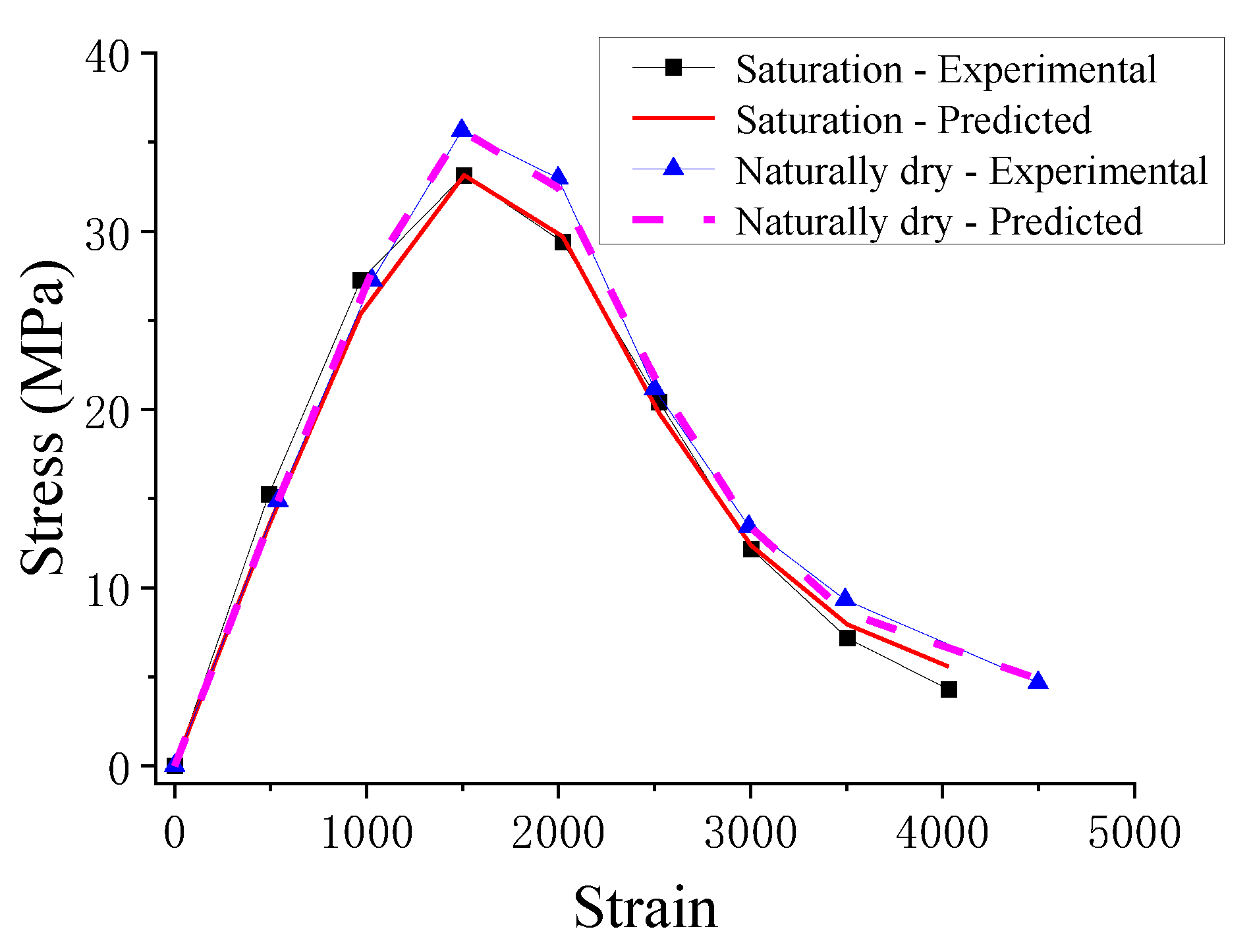
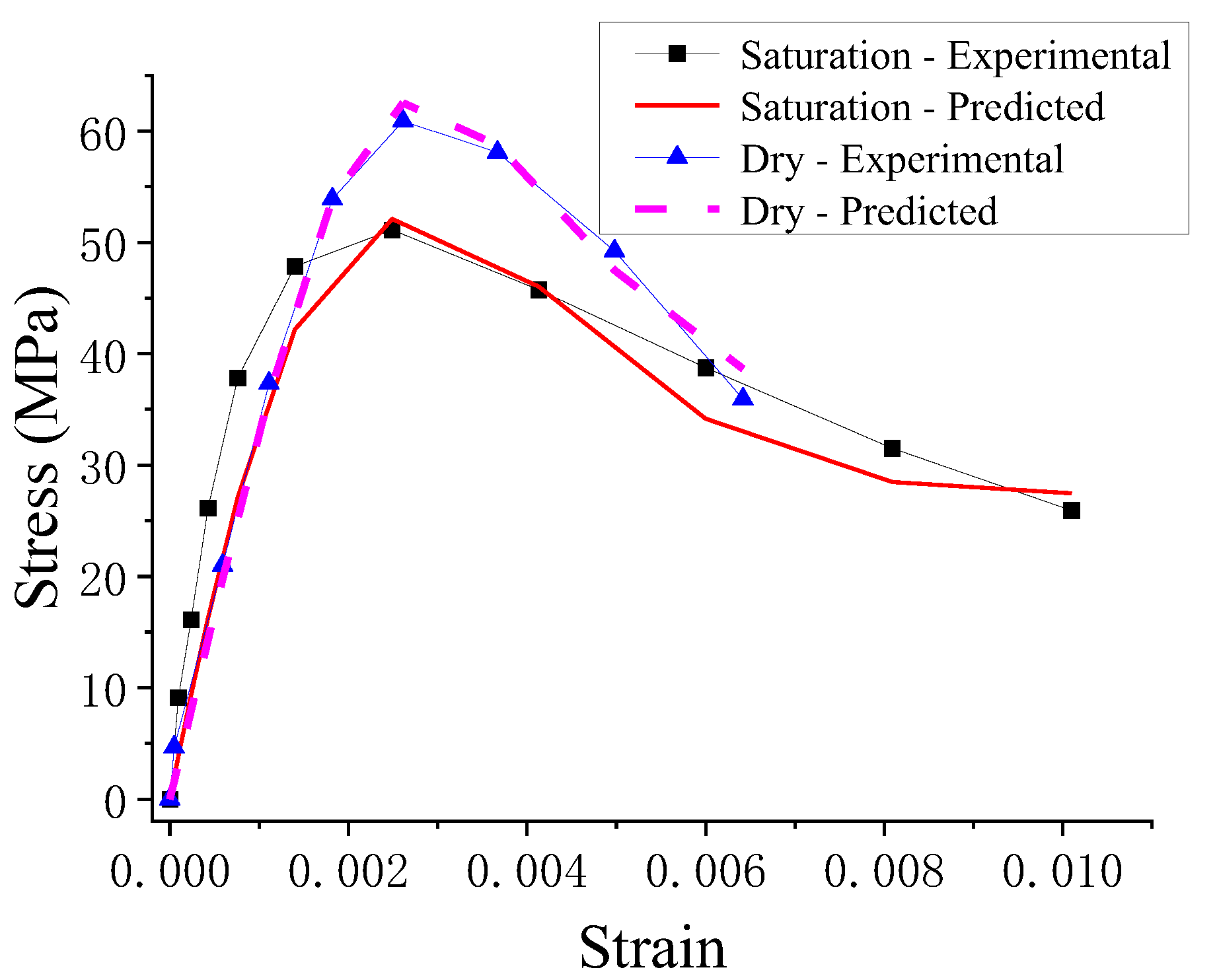
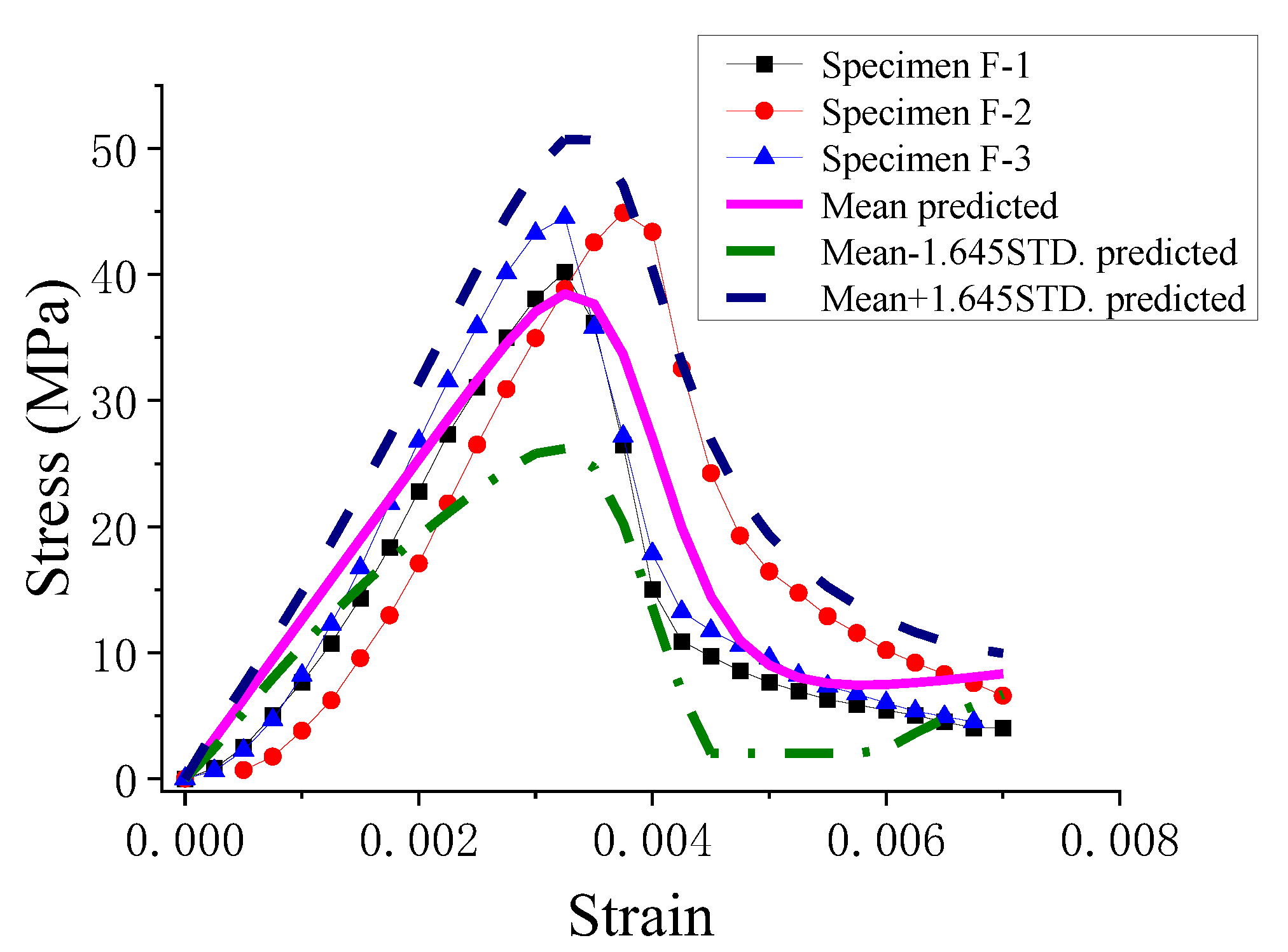

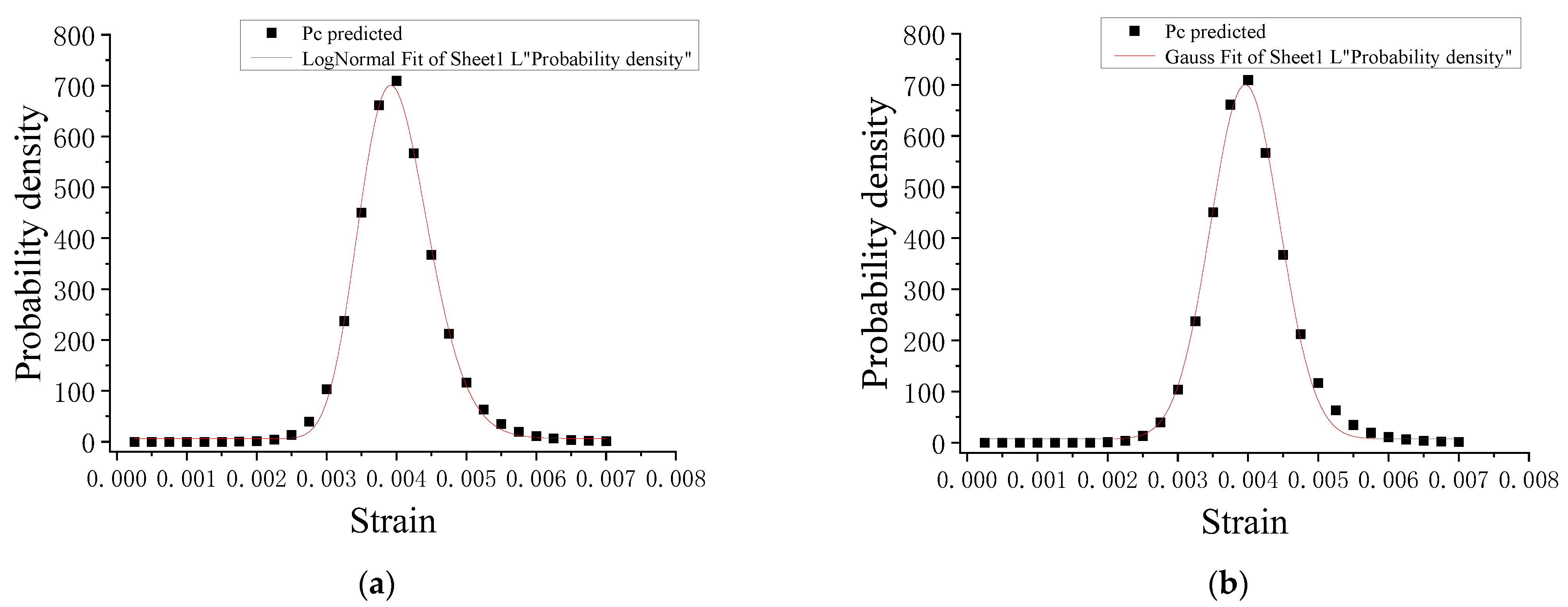

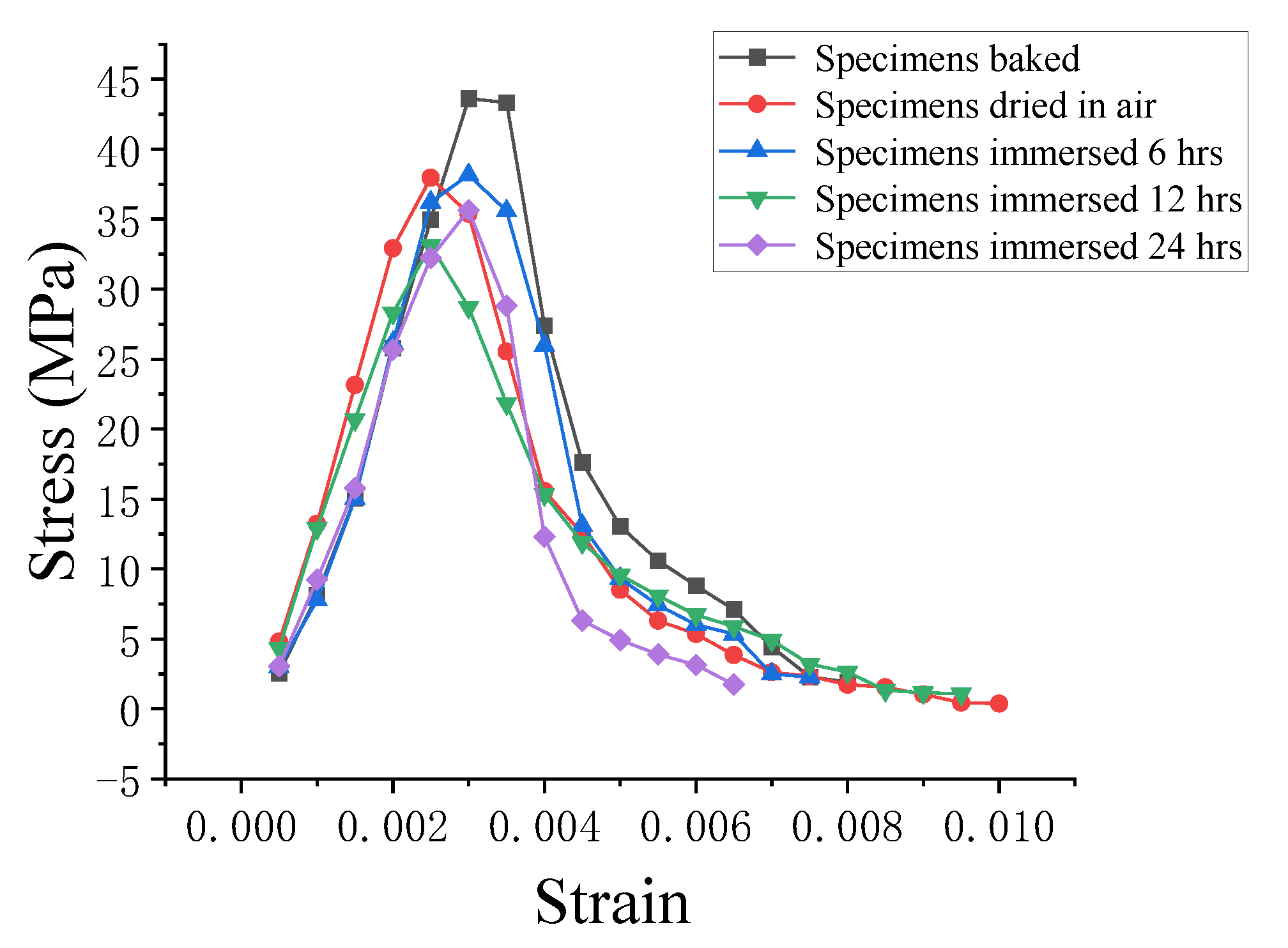


| Raw Material | Cement | Sand | Aggregate | FA | SLP | Water |
|---|---|---|---|---|---|---|
| Weight/kg·m3 | 300 | 720 | 1128 | 50 | 50 | 153 |
| Specific Surface Area (m2 kg−1) | Loss on Ignition (%) | Compressive Strength on 3 d and 28 d (MPa) | Flexural Strength on 3 d and 28 d (MPa) |
|---|---|---|---|
| 316 | 1.8 | 33.3 and 61.9 | 5.9 and 8.5 |
| Apparent Density (g/cm3) | Moisture Content (%) | Water Absorption Rate (%) | Clay Content (%) | Mud Content (%) | Soundness (%) | Chloride Content (%) |
|---|---|---|---|---|---|---|
| 2.64 | 0.04 | 0.4 | 0 | 0 | 2.0 | 0 |
| Specimen Type | Cubic Specimens | Prismatic Specimens | ||||
|---|---|---|---|---|---|---|
| Size/mm | 150 × 150 × 150 | 100 × 100 × 300 | 100 × 100 × 300 | 100 × 100 × 300 | 100 × 100 × 300 | 100 × 100 × 300 |
| Numbering | B-1 | A-1, A-2 | F-1 | E-1 | C-1 | D-1 |
| B-2 | A-3, …, A-8 | F-2 | E-2 | C-2 | D-2 | |
| B-3 | A-9, A-10 | F-3 | E-3 | C-3 | D-3 | |
| Curing method | Standard curing | By keeping them wet under plastic sheeting for 28 days | ||||
| Preparation | Dried in the air on an indoor ground for 28 days | Dried in the air on an indoor ground for 28 days and then baked at 50 ± 2 °C for 48 h | Dried in the air on an indoor ground for 28 days and then immersed in tap water for 6 h | Dried in the air on an indoor ground for 28 days and then immersed in tap water for 12 h | Dried in the air on an indoor ground for 28 days and then immersed in tap water for 24 h | |
| Specimen Group | A | C | D | E | F | B |
|---|---|---|---|---|---|---|
| Load stage | Before peak → After peak | |||||
| Loading rate | 300 kN/min → 0.18 mm/min | 600 kN/min → 0.36 mm/min | ||||
| Specimen Group | Immersion Time t (h) | Average Mess m (kg) | Average Moisture Content k | Average Saturation w | Average Strength fc (MPa) | Strength Deterioration Ratio ds |
|---|---|---|---|---|---|---|
| A | Baked | 7.180 | 0.000 | 0.000 | 43.620 | 0.000 |
| B | Dried in air | 7.256 | 0.0105 | 0.444 | 37.957 | 0.130 |
| C | Standard curing | / | / | / | 42.588 | / |
| D | 6 | 7.275 | 0.0132 | 0.558 | 38.169 | 0.125 |
| E | 12 | 7.333 | 0.0214 | 0.901 | 33.129 | 0.241 |
| F | 24 | 7.350 | 0.0237 | 0.999 | 35.642 | 0.183 |
| fck (Mpa) | 20 | 25 | 30 | 35 | 40 | 45 | 50 | 55 | 60 | 65 | 70 | 75 | 80 |
|---|---|---|---|---|---|---|---|---|---|---|---|---|---|
| fcm (Mpa) | 30.3 | 36.3 | 41.8 | 47.9 | 53.8 | 60.5 | 66.2 | 72.2 | 78.1 | 84.6 | 91.1 | 97.6 | 104.2 |
| Ec (Gpa) | 26.3 | 28.8 | 30.9 | 32.4 | 33.5 | 34.5 | 35.5 | 36.6 | 37.1 | 37.6 | 38.1 | 38.6 | 39.1 |
| Ac,1 | 0.003 4 | 0.005 4 | 0.004 9 | 0.003 1 | −0.00 09 | −0.00 57 | −0.01 08 | −0.01 44 | −0.02 38 | −0.03 56 | −0.05 11 | −0.07 30 | −0.10 94 |
| Ac,2 | 1 | 1 | 1 | 1 | 1 | 1 | 1 | 1 | 1 | 1 | 1 | 1 | 1 |
| xc,0 | 1.061 | 1.120 | 1.170 | 1.211 | 1.253 | 1.285 | 1.302 | 1.318 | 1.337 | 1.349 | 1.354 | 1.349 | 1.335 |
| pc | 2.218 | 2.491 | 2.758 | 3.015 | 3.297 | 3.560 | 3.776 | 3.988 | 4.219 | 4.406 | 4.549 | 4.619 | 4.621 |
| δc | 0.206 | 0.189 | 0.172 | 0.164 | 0.156 | 0.156 | 0.149 | 0.145 | 0.141 | 0.141 | 0.141 | 0.141 | 0.141 |
| εc,k (10−6) | 1470 | 1560 | 1640 | 1720 | 1790 | 1850 | 1920 | 1980 | 2030 | 2080 | 2130 | 2190 | 2240 |
| εcu/εc,k | 3.0 | 2.6 | 2.3 | 2.1 | 2.0 | 1.9 | 1.9 | 1.8 | 1.8 | 1.7 | 1.7 | 1.7 | 1.6 |
| fck (Mpa) | 20 | 25 | 30 | 35 | 40 | 45 | 50 | 55 | 60 | 65 | 70 | 75 | 80 |
|---|---|---|---|---|---|---|---|---|---|---|---|---|---|
| fcm (Mpa) | 30.3 | 36.3 | 41.8 | 47.9 | 53.8 | 60.5 | 66.2 | 72.2 | 78.1 | 84.6 | 91.1 | 97.6 | 104.2 |
| δc | 0.206 | 0.189 | 0.172 | 0.164 | 0.156 | 0.156 | 0.149 | 0.145 | 0.141 | 0.141 | 0.141 | 0.141 | 0.141 |
| Vσc | 6.26 | 6.87 | 7.17 | 7.84 | 8.39 | 9.42 | 9.85 | 10.46 | 11.00 | 11.91 | 12.83 | 13.74 | 14.71 |
| kδc | 2.04 | 1.87 | 1.70 | 1.62 | 1.54 | 1.54 | 1.48 | 1.44 | 1.40 | 1.40 | 1.40 | 1.40 | 1.40 |
| εc,k (10−6) | 1470 | 1560 | 1640 | 1720 | 1790 | 1850 | 1920 | 1980 | 2030 | 2080 | 2130 | 2190 | 2240 |
Disclaimer/Publisher’s Note: The statements, opinions and data contained in all publications are solely those of the individual author(s) and contributor(s) and not of MDPI and/or the editor(s). MDPI and/or the editor(s) disclaim responsibility for any injury to people or property resulting from any ideas, methods, instructions or products referred to in the content. |
© 2024 by the authors. Licensee MDPI, Basel, Switzerland. This article is an open access article distributed under the terms and conditions of the Creative Commons Attribution (CC BY) license (https://creativecommons.org/licenses/by/4.0/).
Share and Cite
Wang, J.; Shan, Z.; Kang, J. Experimental Investigation of Compressive Concrete with Different Immersion Times and Its Stochastic Damage Model. Appl. Sci. 2024, 14, 739. https://doi.org/10.3390/app14020739
Wang J, Shan Z, Kang J. Experimental Investigation of Compressive Concrete with Different Immersion Times and Its Stochastic Damage Model. Applied Sciences. 2024; 14(2):739. https://doi.org/10.3390/app14020739
Chicago/Turabian StyleWang, Jing, Zhi Shan, and Jiawei Kang. 2024. "Experimental Investigation of Compressive Concrete with Different Immersion Times and Its Stochastic Damage Model" Applied Sciences 14, no. 2: 739. https://doi.org/10.3390/app14020739
APA StyleWang, J., Shan, Z., & Kang, J. (2024). Experimental Investigation of Compressive Concrete with Different Immersion Times and Its Stochastic Damage Model. Applied Sciences, 14(2), 739. https://doi.org/10.3390/app14020739






